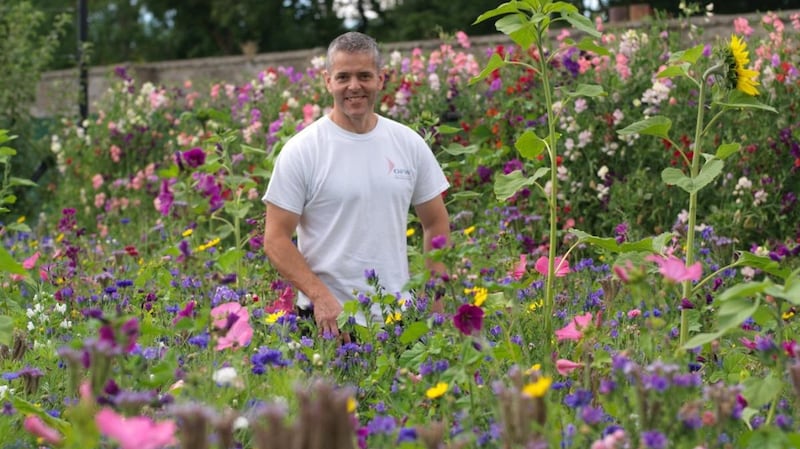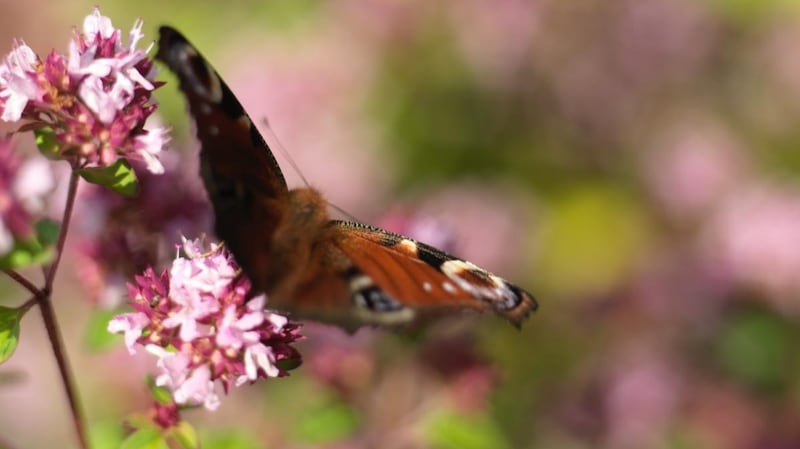Sustainability and climate change are the twin issues radically reshaping the future of gardening, inspiring a new generation to throw away the rule book in favour of creating greener, wilder, planet-friendly outdoor spaces and forcing the world’s horticultural industry to finally start tackling its heavy reliance on plastic, peat, environmentally-harmful chemicals and fossil fuels. Rather than just gardening, it’s now all about gardening with a clear conscience, a challenge that requires ingenuity, resolve and innovative solutions.
So it's wonderful to see these issues being explored and highlighted by some of the country's most talented gardeners, designers and pioneering scientists at this year's Bloom in the Park, the annual Bord Bia-organised event which takes place in Dublin's Phoenix Park from Thursday, May 30th to Monday, June 3rd (see bloominthepark.com).
How we confront the growing problem of marine pollution is an issue that weighs heavily on the minds of the well-known garden design duo Liat and Oliver Schurmann of Mount Venus Nursery. Their medium-sized Aqua Marine underwater show garden for Bord Iascaigh Mhara at Bloom highlights how the world's oceans are being increasingly contaminated by man-made microplastics with shocking consequences for fragile ecosystems, marine life and human health.


These tiny, non-biodegradable fragments of plastic, known as nurdles or microbeads, are typically less than 5mm in size and come from drinks bottles, cosmetics, detergents, packaging, clothing and fishing equipment as well as plastic plant pots. Shamefully, Ireland is the biggest producer of plastic waste in the European Union with an average of 61kg per person per year (see dit.ie for details of Impact, the Irish Microplastic Awareness and Coastal Threats initiative also raising awareness of this issue).
Eighty per cent of the hard landscaping materials used in the Schurmanns' Bloom show garden are being recycled from previous shows while new elements will also be repurposed (mountvenusnursery.com).
It was the effects of last summer's punishing drought and water restrictions on his own garden that inspired Liwen Xiao, assistant professor at the department of civil, structural and environmental engineering at Trinity College Dublin, to explore how cutting-edge environmental, engineering and emerging technologies might be used to conserve this precious natural resource by sustainably treating domestic wastewater for reuse in our gardens.
The result is his small show garden at this year's Bloom, designed in collaboration with Trinity colleagues Tom Grey and Dunzhu Li. Called E3, Water, Climate Change and Sustainable Development, it offers an ingenious, sustainable solution to the growing threat of drought to Irish gardens and garden wildlife (see trinityhaus.tcd.ie for details of TrinityHaus, the college's innovation centre that works "to provide sustainable solutions for buildings, neighbourhoods and cities").
Pollinators
The global decline in pollinators and the threat it poses to food security and biodiversity is an issue preoccupying the minds of many Irish gardeners. It's addressed in Fingal Bee Positive, the large show garden at this year's Bloom designed by Fingal County Council and Technological University Dublin with the help of seasoned Dublin-based garden designer Jane McCorkell.
Intended to particularly engage the interest of children visiting the show, this interactive space will showcase the ways in which gardeners can play a valuable role in reversing the decline by offering a rich variety of pollinator-friendly habitats and shunning the use of pesticides, fungicides and herbicides.
Examples include the show garden’s clover-rich lawn, its use of flowering and fruiting species of trees such as amelanchier and malus, bug hotels, bird boxes, dry stone walls and other decorative, nectar-rich flowering plants such as salvia, geum, digitalis and ivy.
One of Bloom's most seasoned exhibitors, McCorkell says that minimising the use of environmentally harmful materials such as concrete in her show gardens and generously upcycling/recycling elements from previous show gardens has always been a subject close to her heart (for an explanation of how concrete contributes to climate change, see greenspec.co.uk).
"This year we're also going paperless, so there'll be no pamphlets or handouts. Instead we're encouraging visitors to log on to the Fingal County Council website to get the plant list as well as to enter a competition based on the show garden."(Seefingalcoco.ie, tudublin.ie and janemccorkell.com.)
Garden pests
How we deal with garden pests and diseases in sustainable, planet-friendly ways that avoid the use of environmentally harmful chemicals is one of the challenges that eco-minded gardeners grapple with. That’s especially true in a world where climate change and lax biosecurity have resulted in the threat of a host of unfamiliar pests and diseases new to our shores.
Visitors to this year's Bloom looking for some expert advice in diagnosing exactly what's wrong with an ailing plant as well as the best way to nurse it back to bonny good health should head to the Irish Garden stand, where a wide range of the magazine's regular contributors, including editor Gerry Daly, Tanguy de Toulgoet, Klaus Laitenberger, Colm O' Driscoll, Helen Dillon, Mary Keenan, Frances MacDonald, Carl Wright and Carmel Duignan, will be on hand.
To help them to give you a quick and accurate diagnosis, Gerry Daly suggests visitors take some close-up photos of the afflicted plant and/or bring along a sample in a sealed plastic bag. (See garden.ie.)
Wellbeing
Along with a growing awareness of humankind’s responsibility to respect and protect the natural world is a growing appreciation of the many ways in which the natural world does so much to nurture and nourish our own mental, spiritual and physical well-being. The latter is a theme common to a great many of this year’s show gardens, a large number of which are sponsored by non-profit organisations/establishments catering for the needs of people suffering from illness or coping with disabilities.
They include Maeve O'Neill's large show garden Grounded: Growing Conversations Around Mental Illness; the FBD garden by Kevin Dennis; Crumlin Children's Hospital garden by Kieran Dunne and Anthony Ryan; James Purdy's Healthy Ireland garden; Linda McKeown's diversity garden for Enable Ireland (which will be rebuilt at Enable Ireland's new children's centre opening in Curraheen, Cork, later this year); Robert Moore's Memories Are Made of This garden for Dementia Ireland; Tünde Perry's Breath of Life garden for the Marie Keating Foundation (which includes a natural, chemical-free swimming pool); Brian Burke's Connectivity garden for Woodie's; Leonie Cornelius's The Great Outdoors garden for the Irish Wheelchair Association; Rúaidhrí Bashford's Moving Forward garden for Cheshire Ireland; Adrian Eggers's A Chothú agus a Chosaint for Goal; Cabra Community College's Tóg Go Bog É small show garden; and Svaja Vaicula's Healthy Mind Healthy Planet show garden for Lidl.
Trócaire garden
The issue of sustainability is also at the heart of Stolen Land: a Garden for Trócaire, the medium-sized show garden by Cavan-based landscape designer Barry Kavanagh, who has produced a number of gold-medal-winning gardens for Bloom in the past. Kavanagh is a founder of the innovative social enterprise Patch (People are the Climate Heroes) network, the Ireland-wide ‘nature network’ that aims to help combat the problems of habitat loss, habitat fragmentation and climate change.
His design highlights the plight of vulnerable communities being displaced/evicted as a result of unscrupulous corporate 'land grabs' while also drawing attention to the many similarities between the widespread problem of evictions in 19th century Ireland and present-day Guatemala. All elements of this show garden are being sourced from Irish suppliers and will subsequently be either reused or upcycled after this year's show finishes as part of the designer's firm commitment to keeping it local and sustainable (See patchireland.com.)
Upcycling
The Blackwater Gin garden by the Hairy Gardeners, aka Peter Cowell and Monty Richardson, also showcases how inventive upcycling of reclaimed and salvaged materials can lead to the creation of a garden that's both planet-friendly and lovely to look at. Featuring lots of leafy, shade-loving foliage plants and a water feature symbolic of Waterford's Blackwater river (from which the Blackwater Distillery takes its name), its designers describe it as "a little, green oasis . . . a place to listen to the birds, the water and nature." (See petercowell.com.)
Bloom's floral marquee has traditionally been the place where many of the country's very best specialist nurseries exhibit their wonderful, Irish-grown plants and where visitors go to buy the choicest, most hard-to-get varieties. So the fact that an increasing number of the show's most seasoned and respected nursery owners, including Susan and Gerry Harford of Camolin Potting Shed, Finlay Colley of Rare Plants Ireland and Phil Havercroft of Leamore Nursery, have decided to stay away from this year's Bloom is a great shame and an issue that its organiser Bord Bia badly needs to address if it's to continue to woo serious gardeners to the show in years to come.
In the meantime, a diminished number of Irish nurseries will continue to fly the flag for Irish-grown plants at Bloom 2019, including Kilmurry Nursery, Irish Fuchsia Nursery, Kells Bay, O'Reilly Nurseries, Hughes Roses, Mr Middleton and Shady Plants Nursery.
Bloom's conservation zone is where you'll find stands by a wide variety of charity/non-profit organisations playing an important role in raising awareness of a range of environmental issues dear to many Irish gardeners' hearts. The list includes FIBCA, the Federation of Irish Beekeepers' Associations, whose stand will include an observation hive where visitors can see a queen bee at work (don't worry, you'll be looking at her through a protective glass frame); Biodiversity Ireland, GIY, the Irish Wildlife Trust, Celt (Centre for Environmental Living and Training) and Birdwatch Ireland. (See irishbeekeeping.ie; biodiversityireland.ie; giy.ie; iwt.ie; celtnet.org and birdwatchireland.ie.)
Botanical art
The role that the natural world plays as a rich source of inspiration will also be celebrated at this year's Bloom with the seventh annual exhibition of botanical and floral art in the Phoenix Park visitor centre by many members of the Irish Society of Botanical Artists and others including Lynn Stringer, Holly Somerville and Kathrine Geoghegan (See irishbotanicalartists.ie; lynnstringer.net; hollysomerville.com; and kathrinegeoghegan.gallery.)
Last but not least, Ashtown garden, the 2.5 acre sustainably-managed, restored Victorian walled garden situated within the heart of Bloom's showgrounds in Phoenix Park, is a wonderful place to escape the crowds and quietly enjoy the splendour and tranquillity of a fully productive and ornamental garden. Managed sustainably by the Office of Public Works, it's home to not one, not two, but 28 beehives cared for by OPW professional gardener and dedicated bee lover Brian Quinn.
This is another place to find clever and creative ways to support and sustain dwindling populations of pollinating insects, from the garden's nectar-rich annual pictorial meadows to the deliberate selection of predominantly single-flowered (rather than double-flowered) species in its double herbaceous border. The OPW's gardeners will be working in this historic garden throughout much of the show. (See phoenixpark.ie.)











